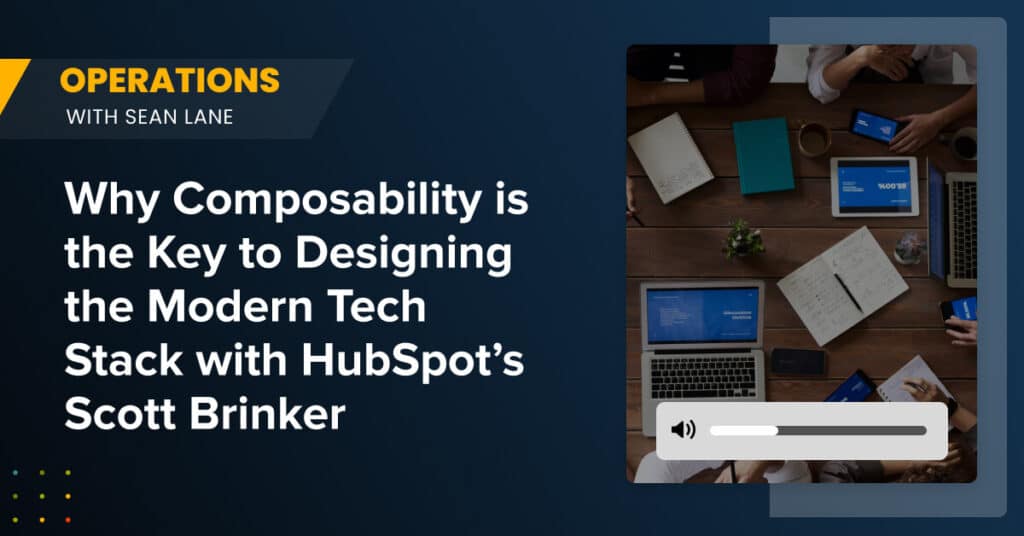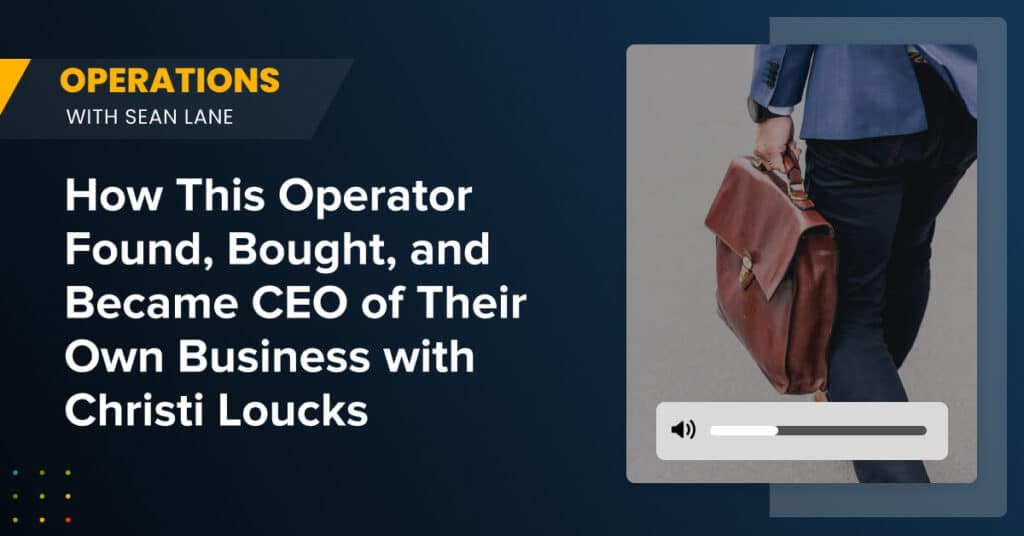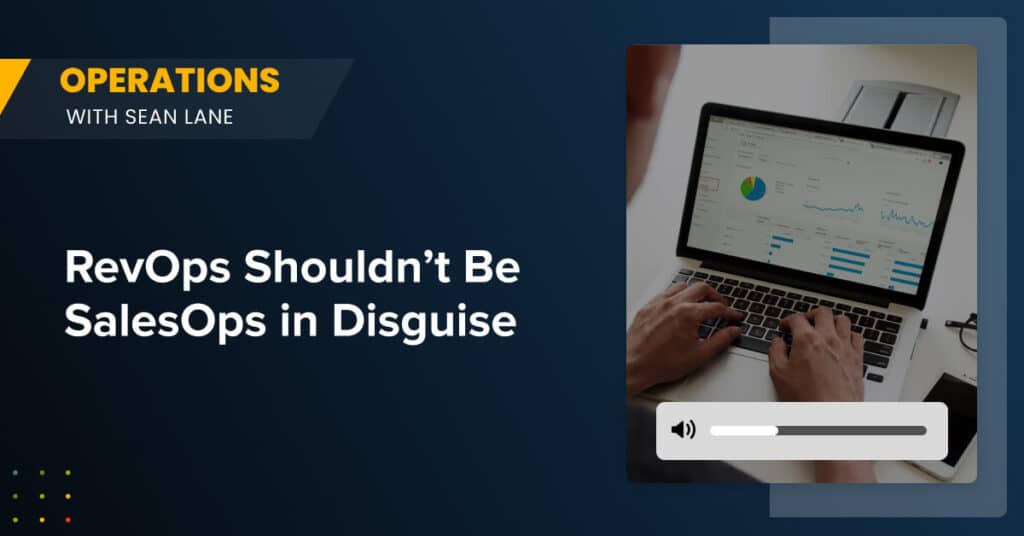Overview
RevOps is a recent and highly dynamic field. Organizations interpret and implement the function differently, and keeping up with the latest is challenging. One thing is clear however: alignment across revenue-generating functions is key to thrive in today’s market. A robust tech stack is central to enabling and optimizing the many moving pieces of your RevOps org.
Key Questions:
➼ How are revops and revenue intelligence changing?
➼ Why is a revops tech stack so important?
➼ How does the revops tech stack evolve as a company grows?
➼ Which type of tools do you prioritize and how do you approach building out a tech stack?
➼ How do you measure the ROI of the tools in your tech stack?
Speakers:
Tyler Simons, Customer Success @Fullcast
Caroline Tien-Spalding, CMO @ Aptology
Sheevaun Thatcher, VP Global Learning & Digital Engagement @ RingCentral
James Hemberg, Sr. Director of RevOps @ Mediafly
Transcript
Ashley: Thank you, everyone, for coming. For today’s topic, we’re going to be chatting about how RevOps intelligence is changing in 2022. It’s a really good topic for this time of the year and we have a really great panel here today who can dive into all the different angles that are important in answering that question.
Caroline: My name is Caroline Tien-Spalding. What am I doing now? That could be answered in a number of ways, but I guess my title is the Chief Marketing Officer for Aptology and we help people understand people at work and optimize against that. My career spans B2C and B2B, started in sales and then went into marketing and then product and then all the way back into marketing. That’s my little tour of Caroline in 5 seconds. I started talking about reverse final analysis in 2009 so we could be here for the next 5 hours. Just fair warning. I’m really passionate about understanding what works for the business.
James: James Hamburg, I’m the senior director of revenue operations at Mediafly. We are a presentation software that sales reps use in every meeting that they go into looking at content engagement, how content is being used, and tying content back to revenue.. very much sit within the revenue intelligence space. And my focus currently, Mediafly is really the alignment across the go-to-market teams as it relates to the buyer’s journey and keeping everyone accountable for revenue.
Sheevaun: Hi, I’m Sheevaun Thatcher. I’m the VP of Digital Learning and Enablement at RingCentral. My purview is pretty much supporting the whole go-to-market effort when it comes to enablement and training within the organization for employees, customers, and partners. And when it comes to my link to RevOps, a lot of the work we do is fully in support of the revenue operations of the organization.
Tyler: I’m Tyler Simons, and I head customer success at Fullcast. And for those of you that don’t know, Fullcast is a go-to-market RevOps platform. We go from territory planning all the way to execution that ties really closely back into our topic today, which is revenue intelligence we work with all of our customers on that stuff regularly.
We’re going to start with just the very broad question: What is revenue intelligence in your own words? And how do you think it’s changing? We can start with James, I’ll throw it out there, put him on the spot.
What is revenue intelligence? [3:53]
James: To me, revenue intelligence is focusing on the data and insights to create the most consistent experience across the buying journey. Across all the go-to-market teams, everyone that touches it, the buyer, ensuring that they have the most relevant insights at the point of decision, when they’re thinking about how to interact and what to do next in terms of engaging the buyer.
Caroline: I think it’s changed quite a bit and it’s changing. I think it started with sales tech almost, right? What are the pieces to understand territory, understand pipeline, understand deal velocity. And it’s changed into full cycle, full buyer journey, understanding and optimization, which is such a broad term, and it covers pre-pipe, the entire experience of buying and even in customer service. When you think about land and expand, which there’s two ways of making more money, right? You’re getting more customers, you’re getting more money from the same customers. And that second half is really blooming as well in terms of understanding how you can optimize the buyer journey after the purchase for expansions, either inside, so inside the company, or through referrals and really empowering there is an entire world of rev tech that goes into helping us understand what’s going on where. And I think that’s really going to be impactful for 2022 as these teams, their scope is just exploding.
Sheevaun: When I think about it, to use some analogies: You’ve got microscopes, you’ve got telescopes, and then you’ve got binoculars. In the past, we’ve had microscopes where we’re zooming in on the data and not really paying attention to everything that’s out there and letting the data drive it. And that worked up until the point when we no longer had the same kind of contact that we’ve had with our customers that we have in the past.
On the telescope side of it, we’re going to predict out there. What does it look like, way out, without again looking at what’s happening in the present. And we found very quickly that predictions don’t always work, especially when the world changes. And so that’s been difficult to manage as well.
But where we are right now is in the binocular stage, which is we can kind of see up close, but we can kind of see far away, and we’re not too far, not too close, but really focusing on what’s going by and really on the customer journey. We used to sell. Now we teach people and we are working with people on how to buy. It’s a very different type of conversation.
Tyler: Did you say telescope? So is that kind of where we’re all headed?
Sheevaun: Well, the telescope, it’s more of a strategic view. It’s looking out far into the future. The problem is, as we’ve discovered pretty abruptly in the last 20 months that looking out into the future, it can change in a matter of moments. And so relying just on a telescope to see and predicting where we’re going to be, as well as relying just on the microscope, on the data, isn’t enough. You’ve got to actually lift your head up and look around and see what’s going on. It’s much more about the customer journey in my mind than it ever has been.
Tyler: You almost have to do all three, right? You have to take a look with a microscope…
Sheevaun: All three are part of it. You have to be able to predict, right? But it’s really different, interesting views. And from what I do on my team with the enablement side of the business, we’re much more at the binocular stage. We’re not diving deep down into the data, which is something that traditionally ops people do. And we’re not predicting the future because we’ve seen it change way too often. We’re dealing very much in the present.
How can revenue intelligence help you better reach your prospects? [8:03]
Tyler: Caroline, I read something you wrote about a year or so ago. You coined this term called B2Me, and it talked a bit about personalization and being really hyper-personalized for prospects and customers. And as we’re talking through this revenue intelligence topic, I’m just curious how revenue intelligence can actually help you move towards this B2Me model, which is essentially this hyper-personalization.
Caroline: Yeah. I think there’s a general change in the B2B world. There used to be this separation, I think we called between Sunday night and Monday morning, this assumption that you’re a different person when you’re at home and you’re at work. And certainly, we’ve treated B2B selling very differently from B2C. I come from the B2C world where everything is hyper-personalized and instant and gotten more and more instant. It started kind of fast — when you go into a store and have a shopping experience — but it’s gotten extremely accelerated. You can buy something on your phone instantly.
And when I say something, it could be so many things: services, people, things, even digital goods that are just vaporware, essentially, are being bought instantly. And I think there was a lag in the B2B world where you do have buying committees, and you do have longer sales cycles, but they’re still treated like you still use facsimiles, you know? Long delays… And you admit something and something else comes out on the other side and someone picks it up and that’s really changing. I think there’s an understanding. I know people are going to be like “The marketing person is saying there’s no one-to-many? What is happening here?” Welcome to this fireside chat.
Tyler: This is music to my ears. I used to sit in the AE seat, and I feel like it’s not personalized.
Caroline: The number one basic thing is you don’t want to make it all about the company, right? And just selling features. That’s pretty basic. But getting to a point where you get to B2Me, which is: “Why me as a person, why now? Why in this position? Why, in this context?” The ability to answer these questions is, I think, what sales marketing operations are expected to answer efficiently that’s being disrupted. The idea that Sunday night to Monday morning separation no longer exists. If you’re somebody who thinks of yourself as moving fast and you travel a lot or your life has been impacted in the last 20 months, it absolutely has changed how we’ve worked and ignoring that kind of means the death of you as a business.
So the big trends on B2Me really change the focus. If you go from company-centric to personalized buyer, single buyer person-centric, the way you organize things around it, the buyer journey completely changes, right? If you think of it as a circle, where you have business-to-business, like this business to this business, and the interactions and the ROI calculators, which you still need to have. But, why me? Why now? And how do I buy myself? I think you touched on that, where the buyer wants to be in control, I think we are now used to it. We’re used to having that instant control. I want to educate myself. I want to be able to see the options, and I want to do it at my own pace. And so that’s where you see things like Mediafly, where you get that intelligence on… If your entire workforce, sales marketing, is trying to get these answers to customers, why this solution? Why should you consider it? What are your options? And why is this one in your consideration? How do you know who’s looking at what, and when? And if you don’t, then you’re not answering the right question to be helpful to the buyer on whether or not you’re a fit. And on our side, I’ll point to Sheevaun and her ABC, there’s also a complete shift on the inside on how you look at people, the sellers to be able to achieve B2Me.
What does it mean to have a workforce that has that buyer-centric journey? So reorganization on the product side, on the engineering side, on the marketing side, on the sales side… How do you change that mindset? And how do you empower them with the knowledge to make that possible? It’s not trivial. You don’t just wake up one morning be like: “Oh, we’re going to be buyer-centric today.” How do you do that? So I think there’s a really big trend of getting that instant gratification and answering the right question at the right time for the right person. I think RevOps in 2022 is all going to be about that. It’s going to be about how do we get the company there from a tech perspective, from a people perspective, from a content perspective, it’s really a 360 change to be able to achieve that.
How does tech stack tie into revenue intelligence? [12:56]
Tyler: We had a mention of ABCs, which we’re going to come back to. James, from your perspective, Caroline talked a little bit about tech stack and how that ties into revenue intelligence. I was curious to hear from your perspective what you’re seeing change there and any insights?
James: Yeah, historically, if you think about revenue ops and it’s tech stack, it really starts with CRM. And that’s where you buy all these different pieces within the tech stack that align to the buyer’s journey. And a lot of it’s just being fed back into the CRM as the place to aggregate all the data and keep all the data in one place. What CRM is really becoming, at least in my opinion, is just a collection of all the data. Instead of a customer relationship management database, it’s just a customer database of all that information. And so what revenue intelligence platforms are trying to do is then pull all of that information into a much more usable platform that’s delivering that insight to the reps at the point of decision, giving them that binoculars look into what they’re into the data they’re not looking at a very granular level, but they’re looking at it at the right level to help them make decisions on a day-to-day basis. And so that’s what I think the best revenue intelligence platforms are allowing their reps to do.
I agree with Caroline that it’s going to be such a focus on enabling the reps through that technology to be able to pick what the next best action is going to be based on where the buyer’s currently in their journey.
Tyler: These things that are just sitting on top of the CRM kind of just reading the data and going: “Hey, now is a good time to do X,” and then a little bit later, “Now is a great time to do Y,” so on and so forth?
James: Exactly. And so the key is making sure that you have all those things talking with one another. When anybody looks at it at any part of the buyer’s journey, they get as much of a full picture as possible. I think you’re seeing companies like outreach by companies like Canopy or ZoomInfo by Chorus. They’re trying to build this database of information on a single platform so you can get the most holistic look possible whenever, regardless of where you’re sitting in that circle that’s becoming the buyer’s journey.
How do the ABCs of sales tie back to revenue intelligence? [15:53]
Tyler: Makes sense. ABCs, it’s coming full circle. Tell me a little bit about these ABCs and how you think that ties back into revenue intelligence.
Sheevaun: So who on this has never seen ‘Glengarry, Glenn Ross’, right? I mean, it’s a horrid movie, but everybody in sales has seen it, and ABCs was always Always Be Closing, right? “What have you done for me lately?” And that’s what we focused on when it came to our sellers and the data around the sellers.
Instead, the approach that we’ve been taking is much more the ABCs where we’ve renamed them into:
- What are the Attitudes you’re bringing to the table when you’re speaking with your customers?
- What are the Behaviors you’re exhibiting in order to support the customers and what they’re doing?
- And what are the Competencies you have and that you don’t have that we need to be able to fix and fill that gap so that you really are focused on the customers?
In my team, we encompass the whole customer journey from the beginning to the end. Because I’ve got customer trainings under me, all the partner stuff, all the employees, everything. If there is an issue with a customer, no matter where it is on my team, all of us swarm to that issue to say, what is it? Where is it in the customer’s journey that it’s occurring, the experience? Where is the gap? What are the insights that we’ve discovered? How are we going to fix it? What’s an initiative we can do to fix that? And then how are we going to measure it? What’s the impact? And by doing that, my team at RingCentral, probably more than any other team at RingCentral has a holistic view of the customer through their whole journey from the time they come on through their whole journey until they retire, whatever it is that they do.
This is where the revenue is impacted. Looking at the customer as the customer, as opposed to trying to sell to them. Trying to help them solve the problems that they have by bringing everything you can to the table.
Tyler: How do you begin to understand that? Where do you start?
Sheevaun: You start at the beginning, right? Which sounds ridiculous. But no, you start with the conversations. You start by speaking with your sellers. That feedback loop is critical. You have to have it. We have driven the feedback loop from the moment we started sales enablement here five years ago. We have driven that feedback loop to say: “Get out there with your sellers. Ask them what’s happening. What’s working? What’s not?” Because marketing has a view and marketing can see so far deep. But marketing also makes the assumption that these folks are actually searching in some way, right? How do you tickle them to get them to search? How do you find out what are the challenges that are out there so you can go up to somebody who may not be searching and explain to them why they should? Here’s what you should be searching for. Here are the things you should be looking at. It’s that feedback loop, and it’s not just from the sellers. It’s from the managers as well, from a coaching perspective. Where are the gaps in your sellers? Where are they not meeting the customers’ expectations? Where are the customers leaving us? Are they churning? Are they coming so far down the journey and then all of a sudden they’re going: “Yeah, we’re out.” Why? What’s happening there? And unless you have a feedback loop discovered and real feet on the street, and the more nebulous type of answers that, sometimes you can’t get in the data, you need that feedback loop to fill that in.
What is role of feedback loops in revenue intelligence? [19:02]
Tyler: I just feel like feedback loops are the most underappreciated thing…
Caroline: I think that’s the theme of 2022, right? From data to feedback. There’s no intelligence without a feedback loop, right? There just isn’t! If you know something, you never learn on what comes back. That’s the definition of insanity, right? Doing the same thing and expecting a different result. In 2022, to not become insane. Maybe that’s our timeline.
Tyler: The hard part about it, though, is… I think there’s so much to do, right? That’s where the question is coming from in terms of where do you really start. Because there’s so many things, so many little levers that you can pull and understand. Okay, how does this impact that and so on and so forth that then you forget about the feedback loops because it’s a side thing, even though it’s probably one of the most important things.
Sheevaun: The simple way is just to go out to the selling leadership and ask them where they see the gaps. You did not make your number, Mr. Sales leader, why do you think that is in this quarter? You made your number last quarter, why didn’t you this quarter? What is the gap? And then work with them to find out. Look at your CSATs, right? Talk to your CS. The customer success teams have all of a sudden got a much, much more stronger and prevalent position within organizations because we don’t have the ability to go out and take people golfing and dinners and all of the traditional stuff we’ve done to hold them, right? It can be fun. We don’t have that anymore you have to find out. What is this two dimensional environment that we’re in? What is it that breaks through the noise and helps you not only gain the customers but retain them as well?
Tyler: What do you think, James? Maybe a tech stack perspective. If I’m looking at this whole thing and I’m used to doing my B2B, non-personalized, I’m just going to scale this thing and go crazy…. To I’m realizing that I’ve got a problem and I need to solve it. Where do I start? Does it start with a tech, some kind of tool, or is it just a mindset shift? I’d be curious to hear what your thoughts are.
James: I always start in the same place and that’s with the data. Look at the data and understand what you are measuring. Because you can’t create a feedback loop on something that you can’t measure. You need to be able to measure it first. To Sheevaun’s point, a lot of that is dictated by the input on the conversations you’re having with the business and where they believe you should be measuring what the focus is. When prioritizing where you’re investing in your tech stack, that’s a great place to start if you’re not measuring it today, get something that can. And then from there, measure it and then understand it through the feedback loop, because once you can measure and understand it, you can control it and you can improve it. And so that’s kind of the key steps that I always take when I’m looking at it. When I’m thinking about where to invest in my tech stack moving forward, I really want to understand what the needs of cost to go-to-market teams are. Most of what I do every day isn’t major changes, it’s small tweaks to processes based off of that feedback loop. They could have big results. But once I see a huge gap and I know that there’s nothing I have in place today, that’s when I’ll start thinking about potentially investing in a new piece of technology.
Tyler: Could you give me an example of something like a small tweak that you might make?
James: Yeah. One of the things that we’re working on internally is actually rethinking our methodology. It’s not a small tweak I would say. But implementing a methodology specifically like MEDDPIC. Reps are pretty much doing a lot of these things today, but formalizing it and holding people accountable to it and implementing it there. And understanding through MEDDPIC, what are the things that we’re not getting information on today as a result of the sales cycle? Whether that’s the metrics that we have… When you’re trying to think about metrics it’s, then thinking about your customers and how are you measuring your customers and how are they measuring you in terms of how they’re successful with your platform as well, too.
So by just putting in a little bit of standardization and thinking about it that way, it’s a small change for reps again, because it’s something that they were already doing, but formalizing it and putting in a process both makes it scalable but also really helps us identify where are those gaps already measuring them correctly? And how can we measure them better moving forward?
How do we measure the ROI of any kind of revenue intelligence activity? [23:53]
Tyler: What about ROI? How do we measure the ROI of these tools? Or, how do we measure the ROI of any kind of revenue intelligence related activity that we’re doing? That could be the feedback loops that we’re talking about. This could be moving towards B2Me, like getting more personalized and not scaling up. I’d be curious to hear from everybody. How do we measure it? And where would somebody start there?
Sheevaun: On my side of the business, ROI is measured by increase in productivity and reduction in attrition, whether that’s internal folks or its customers. That’s really how we measure it. RingCentral themselves, we’ve got over 200 different levers that are used to measure the data, of which I don’t get involved with — most of it. But from the enablement side of it, it’s just those two pieces. This is what my CRO cares about: Is productivity going up and attrition going down? And so when the conversations I have are with him, that’s what we talk about.
When I’m going down, lower down the level, we get down to the first line managers and get down to the feet on the street, it’s much more about: have they taken this particular training? Do we have the empathy? Something I’ve discovered is that data doesn’t drive empathy. But empathy can change the data. And so it’s that empathy in 2022, that’s really the knowledge of not only how to exhibit empathy and actually use it, but how that empathetic approach will help change the revenue numbers. And so that’s kind of what we’ve been working on: have we been doing the coaching? For example, in February, we had a million minutes of video and learning done in the month of February alone, across 2000 learners. Those numbers are off the scale. But it’s because at that time, we needed them to be able to understand that it was a different approach. This is how the messaging has changed. This is how you need to be able to work with your customers. It was data driven, no doubt about it. And the ROI was the fact that at the end of February, as I said, we had 1 million minutes worth of learning that had occurred across a very small group of individuals.
Sheevaun: So we know that from the repetition of it and all the learning curve, these are the things I talk about at that level, but it depends on where it is on the chain that I’m talking to folks where the ROI will be different. But ultimately, it’s performance going up attrition going down.
Tyler: Super simple. Caroline, how about you?
Caroline: I think we all want to be very numbers driven. Return on investment is what are you investing in? What’s your return on it? I think that as buyers ourselves, we’re probably going to be more methodical and more… We’re going to have higher standards for what our tools can do for us. To execute on B2Me, you need to have prospect intelligence. You need to have a tech stack… And then you need the people on your side, to people to execute. And there’s been a huge strain on your own people and trying to get that qualitative, I think there’s a lot of qualitative that’s starting to move to quantitative. And I think the tools are starting to be smarter.
It used to be that in your curve of maturity, when you think about RevOps, it was about collecting data at first because you had so little of it. Either that’s about your sellers and your team or your prospects. You had very limited visibility. Or in how they move through the cycle. You might have, like signals here and there. And I think that tech stack is really evolving to help serve the business there. And what I mean by that is you have tools like before I would in marketing issues, let’s say some pieces of collateral, right. And it would be qualitative. It would be driven by a bunch of customer interviews, and then we interpret them. Then we make them into collateral, and then we put that on the web, and then you kind of hope that something comes out of it, right? And I have tools like Mediafly where you empower sellers with it, and you understand who is interacting with it, at what point of the discussion, how far they’re actually getting into it, and whether or not they go and do something else.
So that feedback loop is included in the tech stack. That intelligence to save all of that work and to answer what actually moves things along… Or you have things like Chorus where you can actually record the calls and in marketing instead of doing these interviews… How people say things differently when they’re observed, well, you have that live interaction with the seller and the buyer. I can use the specific wording from the prospect and answer those questions in the way that they ask them.
I mean, that is worth an insane amount right to be able to do that! And on our side, at Aptology, we helped codify behavior, to Sheevaun’s point, You could do all these interviews one by one. But on a 2000 seller unit, that’s an insane amount of effort away from the prospects to do that. Is there a way to understand the behaviors that drive and close the loop on performance? How do you close the loop on performance within the tech stack? So what you can then do is spend your time actioning that intelligence.
That’s probably marketing speak… But how do I make that piece of collateral? How do I put it in the right spot? How do I give it to the right person at the right time? I think we’re going to have a higher bar for tech in 2022 to make RevOps truly rev intelligence and not just operations. Not just collecting and asking people to really have to become these Excel gurus everywhere in all these different formats.
Tyler: It kind of comes back to productivity again. All these tools are really helping people understand the buyer, the prospect, the customer… What they want and how they want it, what they want to do. And it really gets right down to the point where they can then tailor things quickly rather than maybe take guesses at what somebody wants.
So, James, what about you on your end ROI as it relates to the tech stack and revenue intelligence?
James: Those are both really good answers, I’ll try to add to them. I think to their point, a good technology, when you’re investing in it, will have the reporting within it to give you that answer. It should tell you the ROI and the impact that you’re having on your business. Doing the initial investment, there’s always a pain that you’re addressing that you’re thinking about the gaps that you’re trying to measure. And then how do you quantify that through metrics that you’re already measuring as it impacts the business?
How is this going to impact my win rate? How is it going to impact my average sale time or average selling price, that type of thing? So always think about the things that you’re already measuring and how is this going to enhance those? Because we already know that these are important to the business, and that gives me that baseline of improvement that I need to measure it against over the contract term. That’s usually how I think about it.
But most of the best or the best revenue intelligence technologies that I’ve seen will give you a lot of that information as it ingests the data and as you’re using it.
Final Thoughts
Tyler: Thank you. I think we have just enough time for closing remarks.
Sheevaun: I think what’s pretty clear is that it doesn’t matter what viewpoint you’re coming from. We all have to work together to make it work. revenue ops affects every part of the organization, not just a traditional ops role. Everybody needs to be involved in order to turn the dial.
James: Yeah, I think just to add to that, it all goes back to the buyer’s journey. And I think that that’s the reason why it’s all connected, because it all connects back to that.
Caroline: I mean, let’s go from data to feedback to get to intelligence. Luck to everybody out there who’s trying to achieve that, but keep focused and really try to tie it back together, and I think you’ll be really ahead of the game.
Tyler: Awesome. Thank you, all three of you for coming on today. This was really fun. It’s really interesting to hear the different perspectives from each and every one of our panelists today, so thank you again. And thanks to everybody that’s out there listening and joining us.










